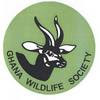The transects were markedly different to those I’d conducted previously, with lush vegetation and much degraded forest amongst palm oil and cocoa plantations and subsistance farmland. Many forest understory and second-growth species such as green crombec, western nicator, grey-headed bristlebill, brown illadopsis and red-bellied paradise flycatcher can be seen (or, in many cases, more often heard) outside the park but migrants were pretty low on the ground, with just two spotted flycatchers seen foraging after a thunderstorm. In the air, however, it was a slightly different story, with one honey buzzard flying overhead, 30 barn swallows seen over a number of different transects and 15 common swifts, with some more also spotted walking between transects. Not huge numbers but an indication of the geographic variation in the swallow and swift wintering ranges at this time of the year in Ghana as these were not recorded on transects elsewhere on this visit. A small number of points on the canopy walkway within the park was where a number of the common swift were viewed and also provided some excellent birding with species such as blue-headed wood dove, red-billed helmet shrike, forest woodhoopoe and Ussher’s flycatcher readily visible. Being in the canopy of a rainforest in the early morning must be one of the best experiences for anyone interested in wildlife.
The continued lack of wood warblers was a little disapointing, indicating that either they are wintering elsewhere, are at very low densities or that they are just not being detected in the dense forest habitat. This has certainly been the most challenging part of the trip so far from a migrant-detection point of view. The lack of wood warblers, or other migrants, during the ringing sessions would, however, seem to add weight to the theory that there just aren’t that many around. Kemp’s longbill, yellow-browed cameroptera and speckled tinkerbird partly made up for it this time around.
A point on the canopy walkway, Kakum National Park

Palm oil plantation, Brenu

After picking up Steve Dodd and Rachel Taylor, the new ringing volunteers, from Accra airport we headed north again to Damongo, unfortunately without two of their bags but they made it on the next flight and joined us three days later! As noted in Chris’s blog from Nazinga further north in Burkina Faso the vegetation in the savanna zone has been recovering from the lack of water and burning, with some low green grass sprouting, a few more leaves on the trees and some low saplings around with dense foliage which was not present before. The birds may have moved around a little with pied flycatchers and willow warblers more numerous on some transects than before and absent on some transects where they had been common previously. It is difficult to say, at this stage, whether there is a pattern here, but one transect which passed through some of the densest canopy open woodland contained 8 pied flycatchers compared to five last time, though only two were on points, and one transect in Mole National Park did not yield a single pied flycatcher whereas six were seen or heard in January. In Mole it seemed as if the vegetation had not grown as much as outside the park and may even have become drier that in January, so perhaps prey species were suffering. Willow warblers were singing a lot more than last time, unsurprising, perhaps, seeing as in a few weeks they will be returning to their breeding grounds to establish territories. Three whinchats were also observed, one woodchat shrike and three melodious warblers, one singing, behaviour which had not been observed on the last visit. A nice male common redstart with a marsh harrier flying overhead brightened up one point and a few house martins also seem to have appeared.
A bit greener than last time - a point on transect 1, Damongo

Whinchat in degraded savanna, Damongo

The ringing effort has been increased with two ringers present. Outside the constant effort sites more nets have been opened and targeted for certain species, which has enabled decent catches of migrants, with 14 in total over six days ringing, including two pied flycatchers, six willow warblers, five melodious warblers (including one recaptured having been ringed in October at the same ringing site) and a nightingale. One little bittern was also caught, though we have yet to confirm if this is the migratory or resident sub-species. Of the more exciting African resident species caught a gabar goshawk and a red-necked buzzard were two highlights and four stunning blue-breasted kingfishers in one morning in Mole just seems a bit greedy to me! After taking down the nets this morning we all went round the corner to see the elephants go for a swim in the nearby lake, with more than a hint of envy in our eyes.
Kogyae awaits for us now, where we hear there has been rain, it will be interesting to see if this precipitates (sorry) another change in migrant numbers. Until next time….
Tina and Rachel ringing a red-billed firefinch in Mole National Park

Willow warbler, Mole National Park

Northern puffback male, Mole National Park








No comments:
Post a Comment
Note: only a member of this blog may post a comment.